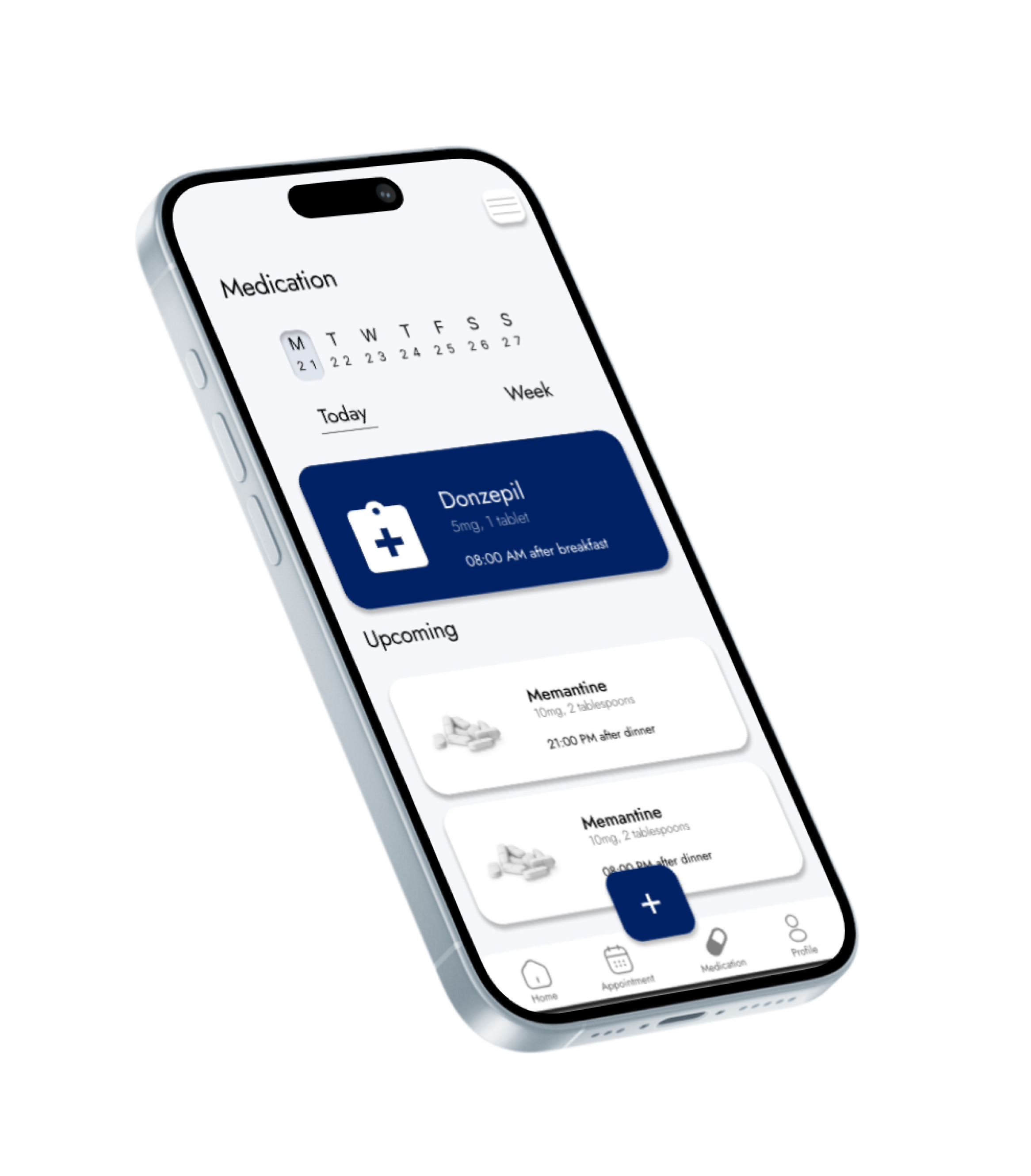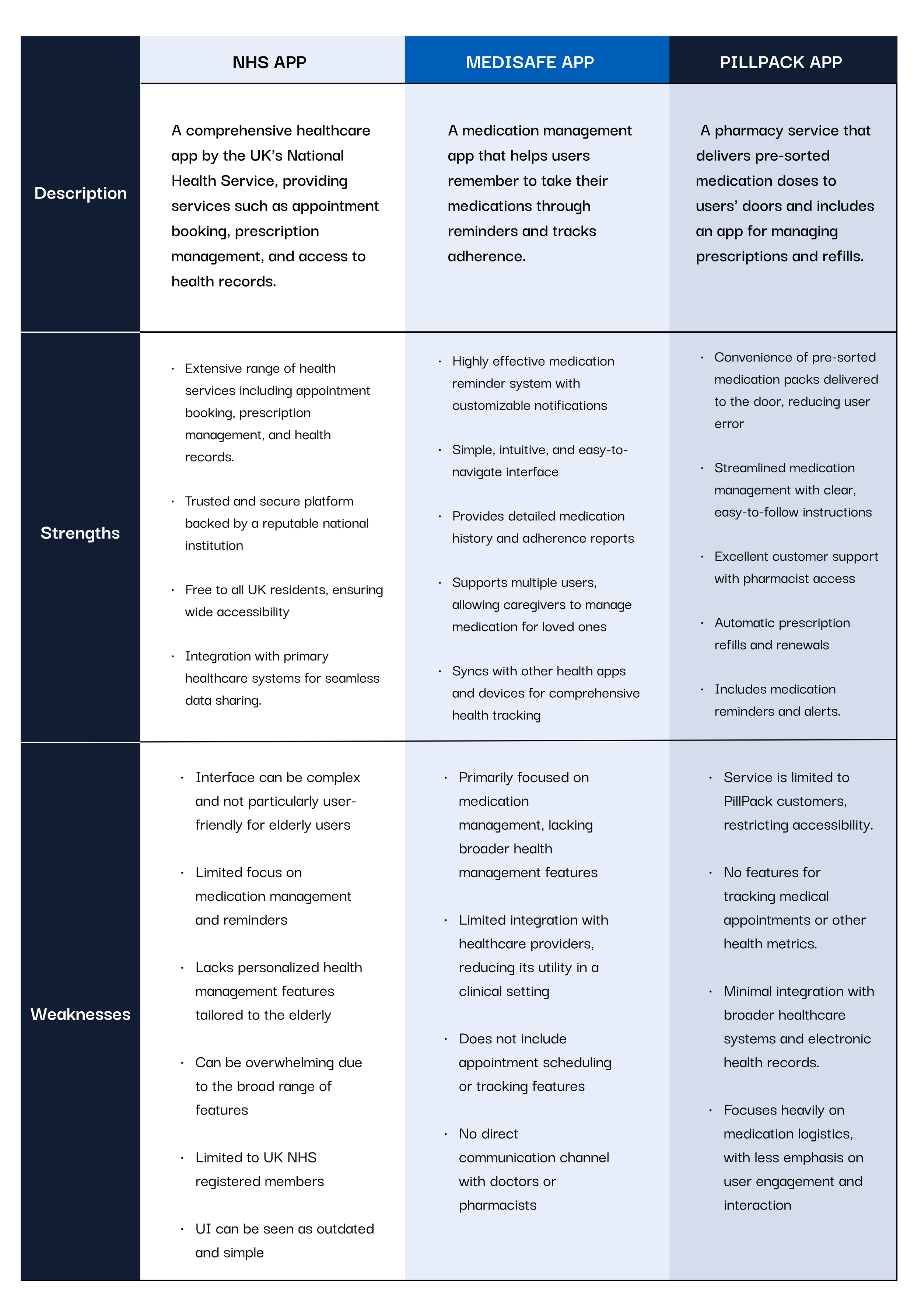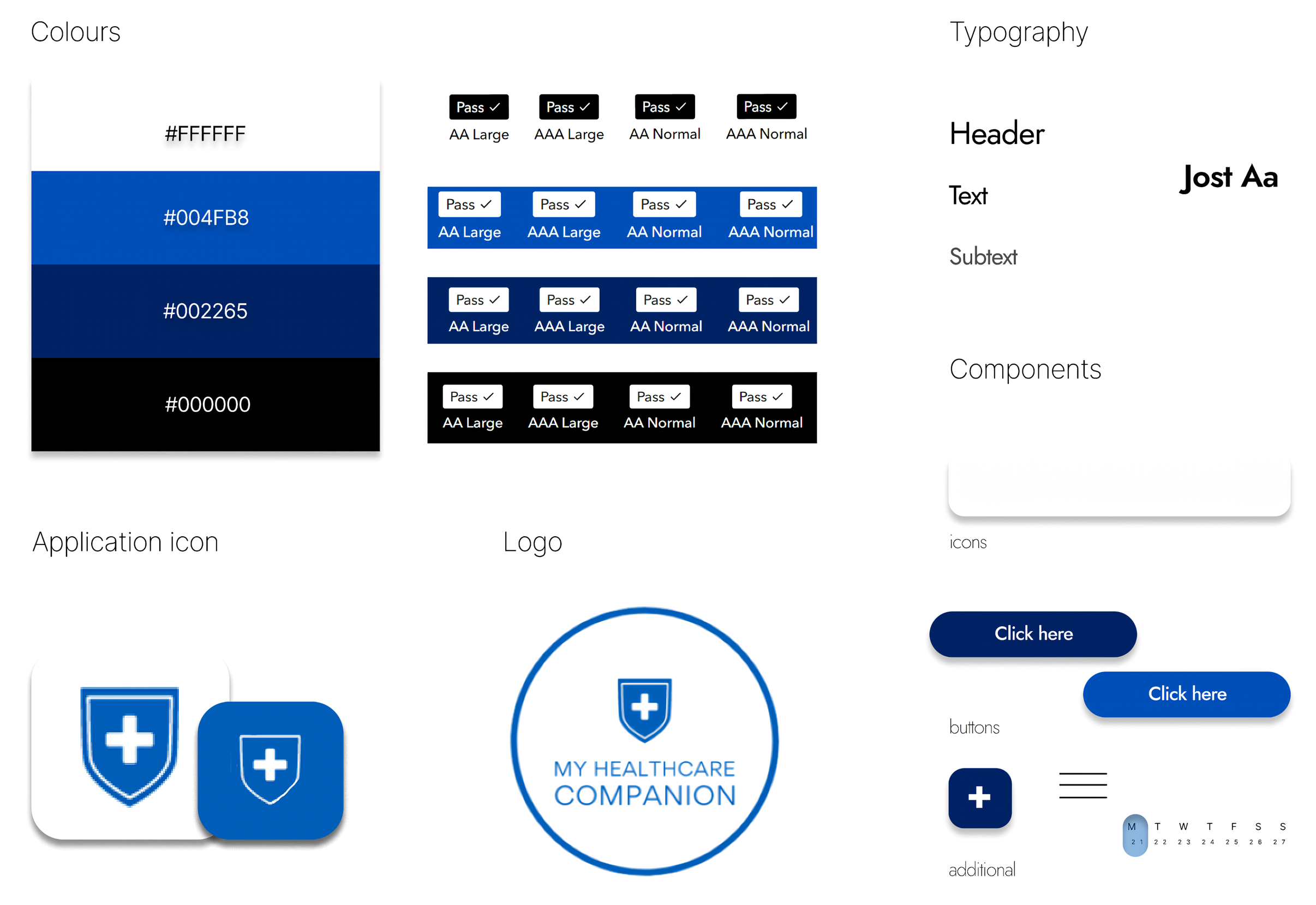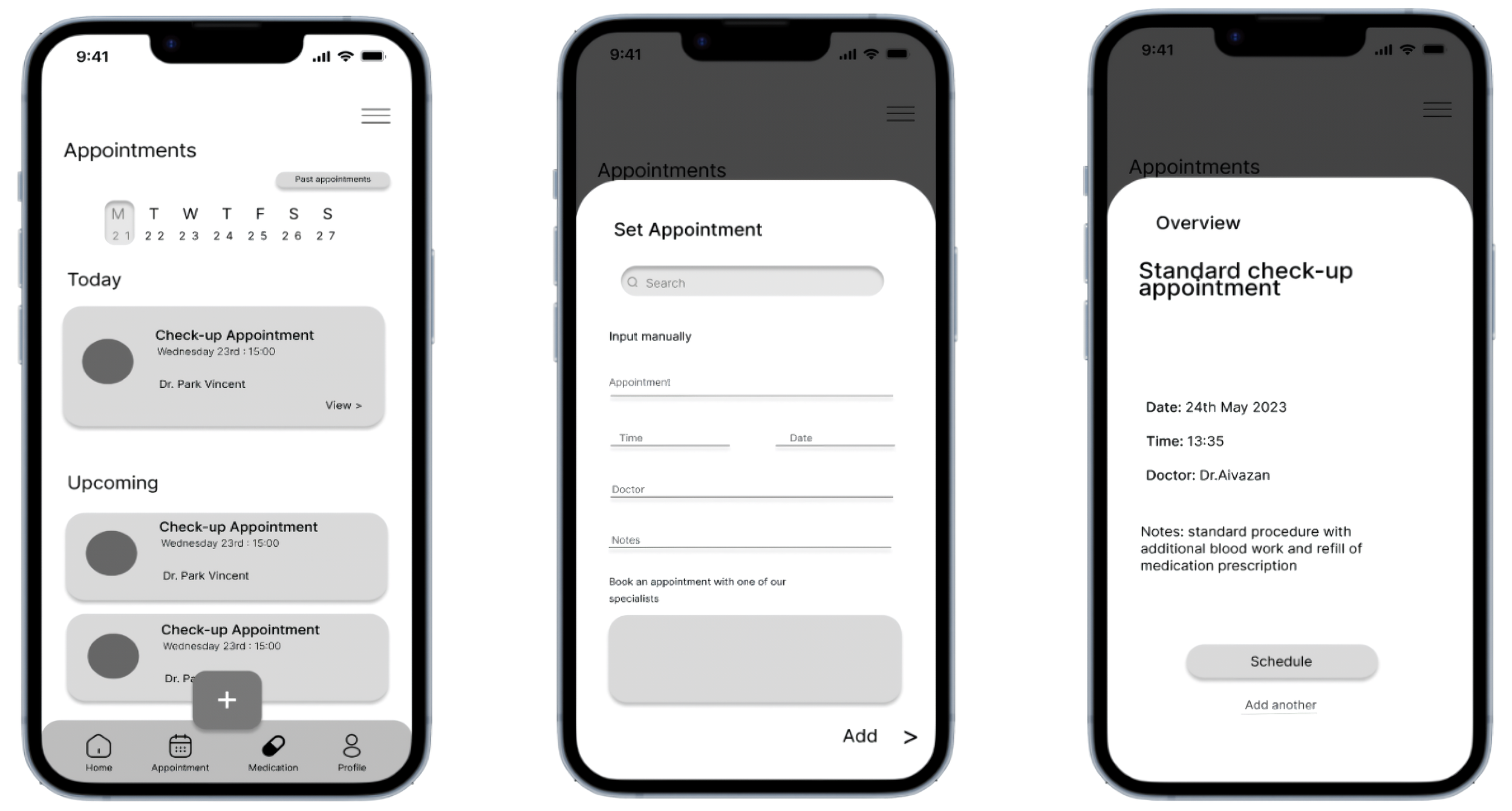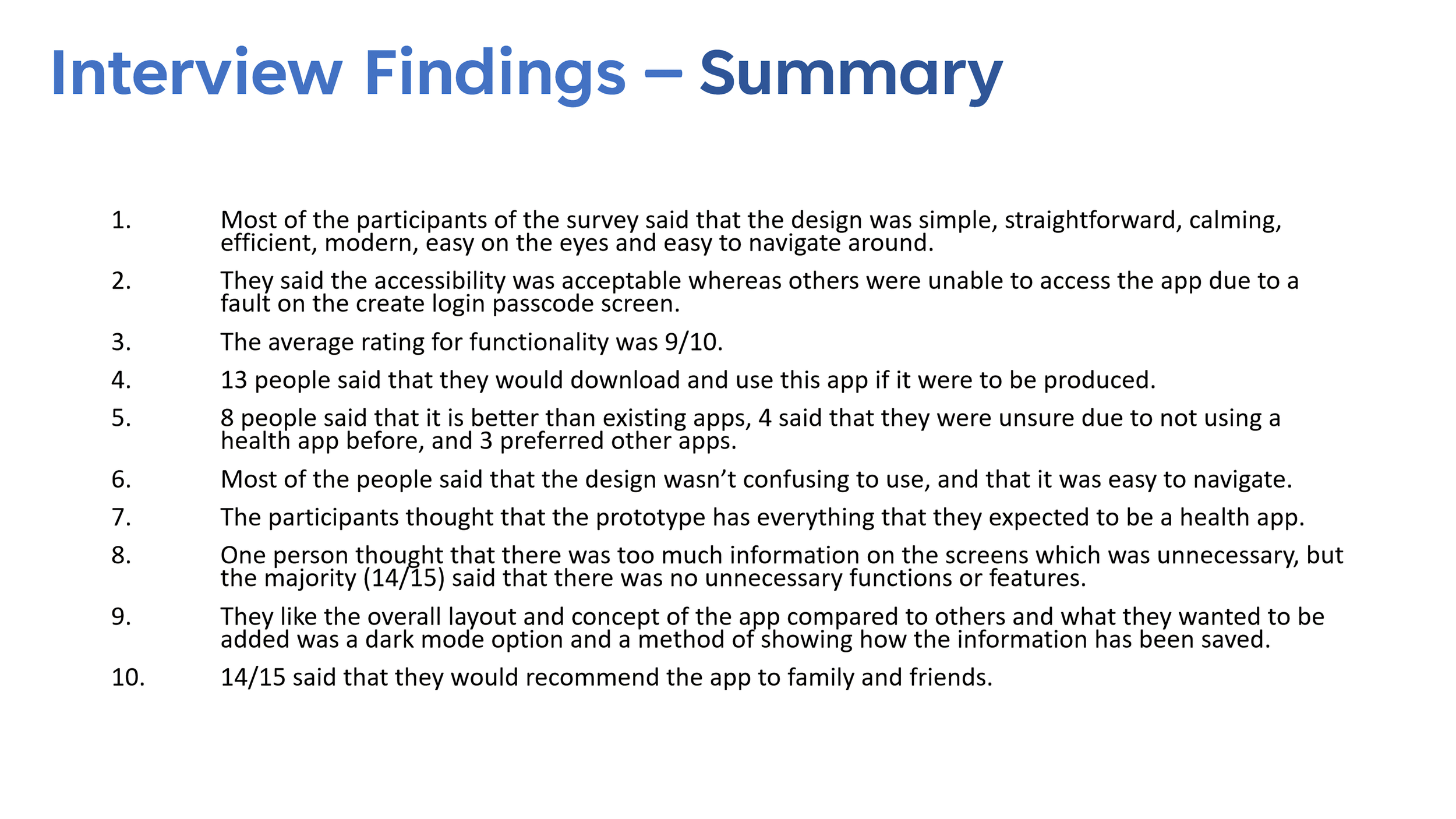Healthcare Companion
Your personal medication and appointment reminder app aimed at the elderly
Project Type:
University Group Project
Role:
UX/I Designer UX Researcher
Tools:
Figma Adobe Illustrator Microsoft Forms Excel
Duration:
5 Months May 2024
Team:
Daria Stefaniak (Me)
Jo Solomon
Fraser Gallagher
Nyasha Kunze
Success Nweke
Overview
Remembering your medication and appointment schedule can be difficult as you get older...
In 2022, as part of a group project assignment, we were tasked to design an innovative healthcare app aimed at addressing the unique challenges faced by the elderly population. The primary focus of our app was to assist elderly users with appointment and medication reminders, as well as tracking their health progress. Recognizing the growing need for digital solutions to support independent living among seniors, we envisioned an app that not only aids in daily health management but also facilitates communication between patients and their healthcare providers. Our goal was to create a user-friendly, intuitive application that could significantly improve the quality of life for elderly individuals, empowering them to manage their health with greater ease and confidence.
Problem Statement
Elderly individuals often struggle with remembering medical appointments and medication schedules, leading to missed appointments, improper medication usage, and overall health decline. Additionally, healthcare providers face challenges in monitoring their elderly patients' adherence to treatment plans and progress due to a lack of real-time data and communication tools. This gap in effective health management can result in compromised care and increased hospitalizations.
Solution
Our solution was to design a comprehensive healthcare app tailored specifically for the elderly, focusing on simplicity and ease of use. The app includes features such as appointment and medication reminders, health tracking, and progress monitoring. Additionally, it provides a platform for doctors to oversee their patients' medication history and health data, enabling timely interventions and personalized care. By integrating these functionalities, the app aims to enhance the elderly's ability to manage their health independently while ensuring healthcare providers can offer better support and oversight.
Research
Researching into the healthcare applications currently available and conducting interviews
Background Research
Elderly individuals often face challenges in managing their health due to cognitive decline and the complexity of multiple medications and appointments. Many struggle with medication adherence and frequently miss medical appointments, leading to worsened health outcomes and increased hospitalizations
Key Statistics
50% of elderly individuals do not take their medications as prescribed, contributing to increased health risks and hospital admissions
20-30% of seniors miss their medical appointments, leading to delayed treatments and unmanaged health conditions
Elderly patients with poor medication adherence are nearly 2.5 times more likely to be hospitalized than those who follow their prescribed regimens
Competitive Analysis
To begin, I researched into the previous attempts at solving this issue through conducting a competitive analysis on the most commonly used and widely recognised apps currently on the market.
The analysis revealed that while existing apps offer various features such as medication reminders, health tracking, and comprehensive health services, they often lack integration and a user-friendly interface tailored specifically for elderly users. Most apps either focus on one aspect of health management or fail to provide seamless communication with healthcare providers, highlighting a significant gap in the market for a holistic, elderly-focused solution that addresses these shortcomings comprehensively.
Feature Analysis
The feature analysis continued the competitive analysis delving into the specific features the apps contain.
While some apps excel in medication management with customizable reminders and detailed adherence reports, others prioritize appointment scheduling and integration with healthcare providers. However, there is a noticeable gap in the market for a comprehensive healthcare app tailored specifically for elderly users.
Such an app would seamlessly integrate medication management, appointment reminders, health tracking, and direct communication channels with healthcare providers, addressing the unique needs of this demographic. This highlights the importance of considering the holistic requirements of elderly users when designing healthcare apps to ensure comprehensive and user-centric solutions.
User Interviews
Once the background research was completed, we gathered 10 participants aged 35-55 to gain a deeper understanding from potential users directly related to their own personal experiences with healthcare technology as well as their pain points and expectations.
Interview Objectives
Gain insights into the specific healthcare needs and challenges faced by users in managing their health and medication regimens through digital platforms.
Assess the usability and user experience of existing healthcare apps among users to identify pain points, frustrations, and areas for improvement.
Explore the features and functionalities that users prioritize and value most in healthcare apps, such as medication reminders, appointment scheduling, health tracking, and communication with healthcare providers.
Gather feedback and suggestions from elderly users to inform the development of a user-centric healthcare app tailored specifically to their needs, preferences, and technological proficiency.
Findings & Analysis
Many apps of this type exist so what can we do to make our stand out amongst the competition?
Persona
Based on the research, a persona was created to capsulate the needs and pain points of each user into one, it represents an elderly user who wishes to gain more independence with their health.
User Scenarios
To further support the user persona, hypothetical scenarios were created to provide examples of the many ways the Healthcare Companion app could be utilised by its users.
Identifying Features
Based on the competitive analysis as well as the survey, careful attention was placed to putting together a priority list of which features to include within the app to not only ensure that the app matches its competition but also has the potential to surpass and exceed user expectations and needs.
Prioritising Features
Due to the narrow deadline window of the assignment, prioritising the features was with this in mind to ensure successfully meeting the deadline with a finished satisfactory product.
Ideation
Once the research was concluded, it was time to start planning the app design and layout.
Before developing the prototype for the app, it was crucial to start off planning the hierarchy and layout of the application’s content. A sitemap was developed to assist with this.
As the app will be aimed primarily at an elderly user group, it was necessary for the interface to be minimalistic and easily navigated thus the amount of sections were limited to four to reduce the risk of confusion.
Sitemap
User-flow Diagram
Based on the main feature of the app being the reminder system, a snippet was included of the user-flow map showcasing an example of how a user would add their prescription to the app for future reminders.
Style Guide
When presenting the style guide for the app, we've opted for a calming and clean interface by selecting a blue, black, and white colour palette. This choice aims to provide a visually soothing experience for our users, particularly the elderly, ensuring that the interface is not overwhelming or straining on the eyes.
The overall design follows a minimalistic and simple approach, with clean lines and spacious layouts to enhance usability. By prioritizing simplicity and clarity, we aim to create an intuitive user experience that allows elderly users to navigate the app with ease and confidence, promoting engagement and adherence to health management routines.
Design
It was time to design the prototype to be used in the usability testing later on...
Low-Fidelity Sketches
A snippet screenshot showcasing the first rough design idea for the final prototype which was then altered throughout the development of the mid-fidelity design.
Mid-Fidelity Prototype
Each person within the group went ahead and developed their own prototype, once that was completed a meeting was setup to review each one and upon critique, the finalised mid-fidelity prototype was created as a hybrid of every member’s ideas to ensure only the top grade quality components were included.
Final Design
Usability Testing
We welcomed back the interview participants to conduct a usability testing on the finalised prototype design to get feedback.
Objectives
To put the initial prototype to the test, an observational study was conducted alongside a follow-up interview with some volunteer participants who fit the user criteria, the study was short and done at the comfort of their own homes as they were mainly friends or family. Overall the aim was to observe how the user interacted with the application followed by a brief interview for further understanding of their emotions and choices as they navigated through the app.
Observe how the users interact with the application, take note of their reactions and body language
Highlight if the user faces any confusion at any point of the interaction process and if so, where did it happen
Be aware of the duration it takes each individual participant to complete the interaction, compare the times between all users to see differences
Findings
Conclusion
Reflecting on the experience of working as a team to develop one final product.
This project marked my first experience working as part of a group to design an app, specifically aimed at improving healthcare management for the elderly. It was a rewarding and challenging endeavour that not only allowed us to create a meaningful product but also taught me invaluable lessons about collaboration and leadership. The process underscored the importance of clear communication, especially when navigating different creative visions and potential miscommunications within a team.
Through this project, I gained essential skills required to be an effective team leader and a better communicator. I learned how crucial it is to harness the collective knowledge and skills of a team, fostering a collaborative environment rather than one of competition. This experience demonstrated that by working together and leveraging each other's strengths, a team can produce a successful and well-rounded product. These lessons in teamwork and communication are ones I will carry forward into my future career in UX, where collaboration is imperative.
Project Takeaways
Moving forward, I am excited to apply the skills and insights gained from this project to new challenges in the field of UX design. I plan to continue honing my ability to lead and collaborate effectively, ensuring that I can contribute to and guide teams towards creating user-centric solutions. Additionally, I aim to stay updated with the latest trends and technologies in UX, continually refining my approach to design and user experience. This project has laid a strong foundation, and I look forward to building upon it as I advance in my career.
Next Steps
